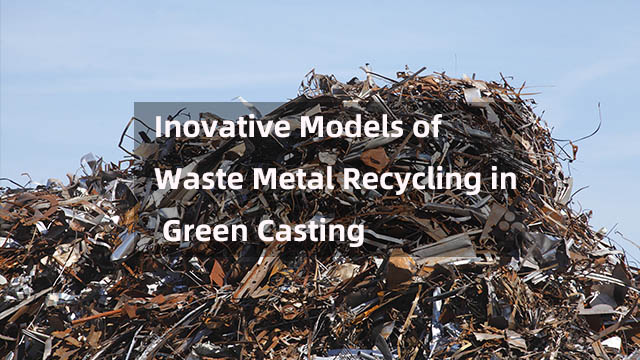Inovative Models of Waste Metal Recycling in Green Casting
2025-01-24 10:42:54 hits:0
In the development of green casting, the recycling of waste metals is of crucial importance. It can not only alleviate resource shortages and reduce the dependence on primary metals but also effectively reduce environmental pollution in the casting process. It is a key link to achieve the sustainable development of green casting. With the progress of technology and the renewal of concepts, a series of innovative models have emerged in the field of waste metal recycling.

Building a Digital Recycling Network
Traditional waste metal recycling channels are scattered and have poor information flow, resulting in low recycling efficiency. The innovative digital recycling network, leveraging Internet technology, builds an extensive recycling information platform. Recycling enterprises, foundries, waste recycling stations, and other parties can share real - time information on the types, quantities, qualities, and prices of waste metals on the platform. Some regional recycling platforms use big data to accurately predict the generation volume and flow direction of waste metals in the region, optimizing the recycling routes. The platform also provides online trading functions, simplifying the trading process, reducing costs, facilitating foundries to make quick purchases, and minimizing losses in intermediate links.
Introducing Advanced Sorting and Purification Technologies
Waste metals often contain a variety of impurities, and traditional sorting and purification methods cannot meet the requirements of high - quality metal raw materials for green casting. Under the innovative model, combined processes such as magnetic separation, flotation, and gravity separation are widely applied. These can effectively separate iron, copper, aluminum, etc., based on the physical properties of different metals. Emerging purification technologies such as electrolytic refining and vacuum melting also play important roles. The former removes impurities and improves purity, while the latter further purifies metals in a high - temperature and oxygen - free environment, reducing the impact of impurities on the quality of castings. These advanced technologies have improved the recycling rate and quality of waste metals, providing high - quality raw materials for green casting.
Promoting Industrial Collaborative Cooperation
The innovation of waste metal recycling in green casting is also reflected in industrial collaboration. Foundries, based on their own production needs, put forward requirements for the quality and composition of waste metals to recycling enterprises, which then carry out targeted recycling and pre - treatment. Research institutions play a bridging role by developing new recycling technologies and processes to provide technical support. For example, a certain foundry jointly established a waste metal recycling base with local recycling enterprises. It also cooperated with research institutions to carry out research projects, developed efficient recycling processes, improved the recycling rate and utilization value of waste metals, realized resource sharing and complementary advantages, and promoted the development of the industry.
Developing a Circular Economy Industrial Chain
The innovative waste metal recycling model focuses on building a complete circular economy industrial chain. Taking the recycling of waste auto parts as an example, recycling enterprises disassemble them, recycle the metals, and conduct pre - treatment. Foundries use the recycled metals to produce new auto parts for the automotive manufacturing industry. The industrial chain also extends to metal deep - processing, waste metal trading, and other links. This realizes the multiple recycling of waste metals, improves resource utilization efficiency, reduces costs, reduces waste emissions, and is beneficial to environmental protection.
The innovative models of waste metal recycling in green casting have made remarkable progress in digitalization, technology, industrial collaboration, and industrial chain construction. They have improved the recycling rate and quality, supporting the sustainable development of green casting. With the continuous progress of technology and innovation, these models will play an even greater role in the field of green casting and promote the casting industry to develop towards a more green and environmentally friendly direction.
Tiegu actively explores innovative paths for waste metal recycling. It builds a digital recycling platform, closely cooperates with multiple recycling enterprises to achieve efficient recycling and precise supply. It introduces advanced sorting and purification equipment to optimize the recycling process. It also deeply cooperates with research institutions to carry out technology research and development, promoting technological upgrades. In the future, Tiegu is willing to work hand in hand with more partners to improve the circular economy industrial chain of green casting and contribute to the development of green casting

 en
en  fra
fra  de
de  ru
ru  gle
gle  th
th  ara
ara  it
it  jp
jp  kor
kor  zh
zh 


